Harbor Freight Tools 69774 User Manual

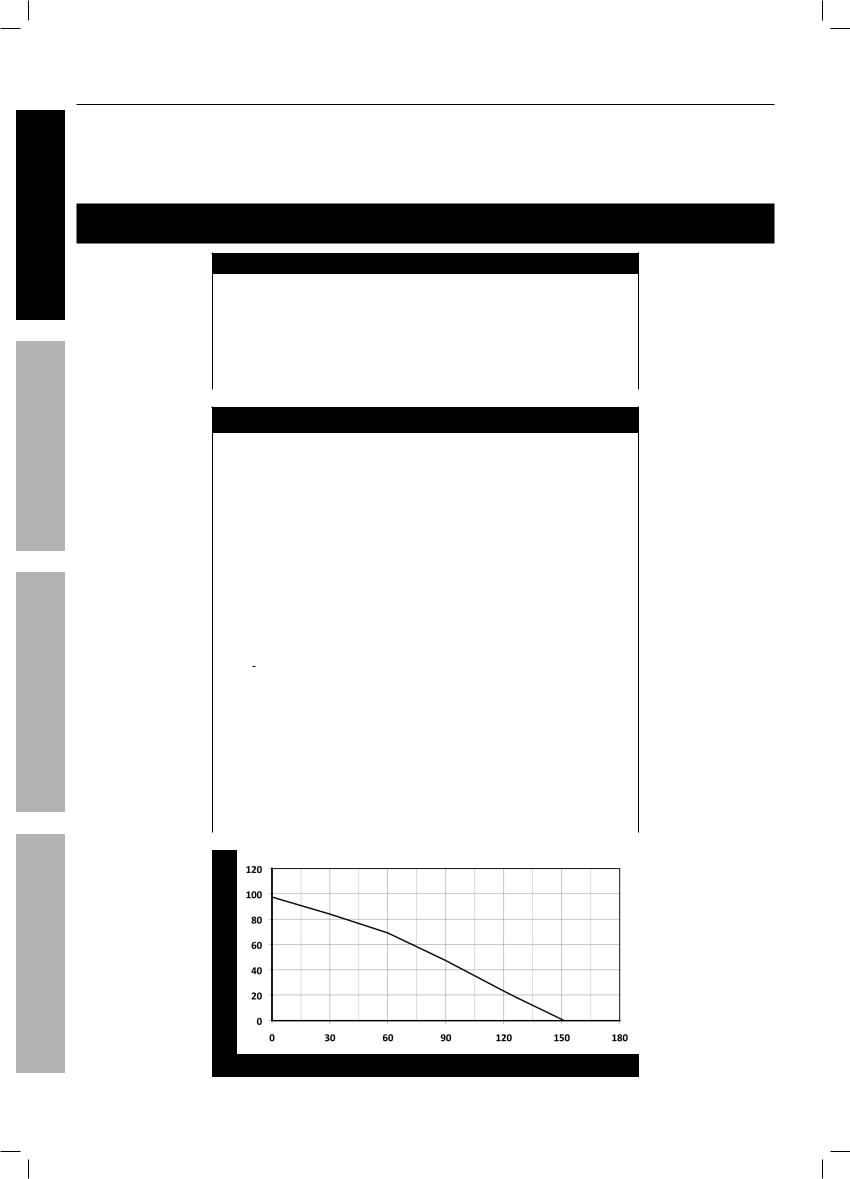
SAFETY
SETUP
OPERATION
Table of Contents
Specifications |
.............................................. 2 |
Maintenance............................................... |
13 |
Safety.......................................................... |
4 |
Troubleshooting......................................... |
17 |
Setup........................................................... |
6 |
Warranties.................................................. |
20 |
Operation................................................... |
10 |
Parts Lists and Diagrams........................... |
22 |
Specifications
Pump
Suction & Discharge Size |
2" NPT |
Discharge Capacity |
151 GPM |
Maximum Discharge Head |
97.5 ft. |
Maximum Suction Head |
26 ft. |
Maximum Pressure |
42.2 PSI |
Mechanical Seal |
Ceramic |
Included Accessories |
Intake Strainer, Hose Clamps, Spark Plug Wrench |
Engine
Displacement |
|
212cc |
|
Engine Type |
|
Horizontal Single Cylinder 4 stroke OHV |
|
|
EPA phase III compliant |
||
|
|
||
Cooling System |
|
Forced air cooled |
|
Fuel |
Type |
87+ octane unleaded gasoline |
|
Capacity |
0.9 Gallons / 3.6 Liters |
||
|
|||
|
Type SAE |
10W-30 above 32° F |
|
Engine Oil |
5W30 at 32° F or below |
||
|
|||
|
Capacity |
0.5 Quarts / 0.5 Liters |
|
Run Time @ 50% Load with full tank |
3 hr. |
||
Sound Level at 22 feet |
104 dB |
||
Bore x Stroke |
|
70 mm x 55 mm |
|
Compression Ratio |
|
8.5:1 |
|
Rotation viewed from PTO |
Counterclockwise |
||
(power takeoff - the output shaft) |
|||
|
|||
|
Shaft |
3/4" x 2.41" |
|
|
|
|
|
Shaft |
Keyway |
3/16" (4.76 mm) |
|
|
|
|
|
|
End Tapped |
5/16" - 24 UNF |
|
|
|
|
|
|
Type |
NGK® BP-6ES |
|
Spark Plug |
NHSP® / Torch® F6TC |
||
|
|||
|
Gap |
0.7 - 0.8 mm |
|
Valve Clearance |
Intake |
0.10 - 0.15 mm |
|
Exhaust |
0.15 - 0.20 mm |
||
|
|||
No Load Speed |
|
3,800 ±100 RPM |
|
MAINTENANCE
|
|
PERFORMANCE CURVE |
|
|
Discharge Head (ft.) |
|
|
|
|
|
|
|
|
Flow (Gallons/minute) |
|
Page 2 |
|
For technical questions, please call 1-800-520-0882. |
ITEM 69774 |
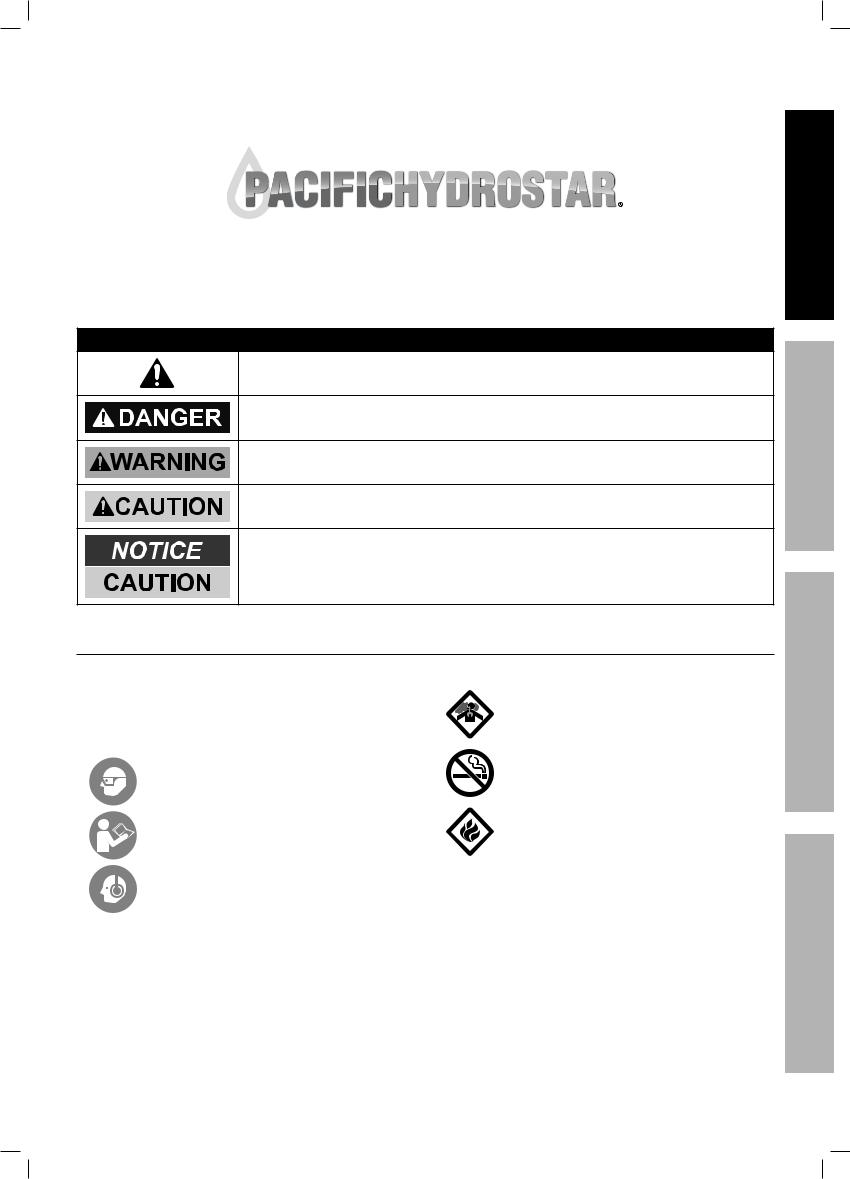
SAFETY
WARNING SYMBOLS AND DEFINITIONS
This is the safety alert symbol. It is used to alert you to potential personal injury hazards. Obey all safety messages that follow this symbol to avoid possible injury or death.
Indicates a hazardous situation which, if not avoided, will result in death or serious injury.
Indicates a hazardous situation which, if not avoided, could result in death or serious injury.
Indicates a hazardous situation which, if not avoided, could result in minor or moderate injury.
Addresses practices not related to personal injury.
SETUP
Symbol Definitions
Symbol |
Property or Statement |
|
Symbol |
Property or Statement |
RPM |
Revolutions Per Minute |
|
|
WARNING marking concerning |
|
|
Risk of Respiratory Injury. |
||
|
|
|
|
Operate engine OUTSIDE and far away |
HP |
Horsepower |
|
|
|
|
|
from windows, doors, and vents. |
||
|
|
|
|
WARNING marking concerning |
|
WARNING marking concerning |
|
|
|
|
|
|
Risk of Fire while handling fuel. |
|
|
Risk of Eye Injury. Wear ANSI-approved |
|
|
|
|
|
|
Do not smoke while handling fuel. |
|
|
safety goggles with side shields. |
|
|
|
|
|
|
WARNING marking concerning |
|
|
|
|
|
|
|
Read the manual before set-up and/or use. |
|
|
Risk of Fire. |
|
|
|
Do not refuel while operating. |
|
|
|
|
|
Keep flammable objects away from engine. |
|
WARNING marking concerning |
|
|
|
|
Risk of Hearing Loss. |
|
|
|
|
Wear hearing protection. |
|
|
|
OPERATION
MAINTENANCE
ITEM 69774 |
For technical questions, please call 1-800-520-0882. |
Page 3 |

SAFETY
SETUP
OPERATION
MAINTENANCE
Safety Warnings
WARNING! Read all instructions.
Failure to follow all instructions listed below may result in fire, serious injury and/or DEATH.
The warnings and precautions discussed in this manual cannot cover all possible conditions and situations that may occur. It must be understood by the operator that common sense and caution are factors which cannot be built into this product, but must be supplied by the operator.
SAVE THESE INSTRUCTIONS
Set up Precautions
1.Gasoline fuel and fumes are flammable, and potentially explosive. Use proper fuel storage and handling procedures. Do not store fuel or other flammable materials nearby.
2.Have multiple ABC class fire extinguishers nearby.
3.Operation of this equipment may create sparks that can start fires around dry vegetation. A spark arrestor may be required. The operator should contact local fire agencies for laws or regulations relating to fire prevention requirements.
4.Set up and use only on a flat, level, well ventilated surface.
5.Use only lubricants and fuel recommended in the Specifications chart of this manual.
6.Wear ANSI-approved safety goggles, heavy-duty work gloves, and dust mask/respirator during set up.
Engine Precautions
Follow engine precautions and instructions in the included engine instruction manual.
Operating Precautions
1.CARBON MONOXIDE HAZARD Using an engine indoors CAN KILL
YOU IN MINUTES.
Engine exhaust contains carbon monoxide. This is a poison you cannot see or smell.
NEVER use inside a home or garage, EVEN IF doors and windows are open.
Only use OUTSIDE and far away from windows, doors, and vents.
2.Keep children away from the equipment, especially while it is operating.
3.Do not touch Pump engine during use.
4.Never store fuel or other flammable materials near the Pump engine.
5.Industrial applications must follow OSHA requirements.
6.Do not leave the equipment unattended when it is running. Turn off the equipment (and remove safety keys, if available) before leaving the work area.
7.Engine can produce high noise levels. Prolonged exposure to noise levels above 85 dBA is hazardous to hearing. Always wear ear protection when operating or working around the gas engine while it is operating.
8.Wear ANSI-approved safety glasses, hearing protection, and NIOSH-approved dust mask/ respirator under a full face shield along
with steel-toed work boots during use.
9.People with pacemakers should consult their physician(s) before use. Electromagnetic fields in close proximity to a heart pacemaker could cause pacemaker interference or pacemaker failure. Caution is necessary when near the
engine’s magneto or recoil starter.
10.Use only accessories that are recommended by Harbor Freight Tools for your model. Accessories that may be suitable for one piece of equipment may become hazardous when used on another piece of equipment.
11.Do not operate in explosive atmospheres, such as in the presence of flammable liquids, gases, or dust. Gasoline-powered engines may ignite the dust or fumes.
Page 4 |
For technical questions, please call 1-800-520-0882. |
ITEM 69774 |

Operating Precautions (cont.)
12.Stay alert, watch what you are doing and use common sense when operating this piece of equipment. Do not use this piece of equipment while tired or under the influence of drugs, alcohol or medication.
13.Do not overreach. Keep proper footing and balance at all times. This enables better control of the equipment in unexpected situations.
14.Dress properly. Do not wear loose clothing or jewelry. Keep hair, clothing and gloves away from moving parts. Loose clothes, jewelry or long hair can be caught in moving parts.
15.Parts, especially exhaust system components, get very hot during use. Stay clear of hot parts.
16.Do not cover the engine or equipment during operation.
17.Keep the equipment, engine, and surrounding area clean at all times.
18.Use the equipment, accessories, etc., in accordance with these instructions and in the manner intended for the particular type of equipment, taking into account the working conditions and the work to be performed. Use of the equipment for operations different from those intended could result in a hazardous situation.
19.Do not operate the equipment with known leaks in the engine’s fuel system.
20.This product contains or, when used, produces a chemical known to the State of California to cause cancer and birth defects or other reproductive harm. (California Health & Safety Code § 25249.5, et seq.)
21.When spills of fuel or oil occur, they must be cleaned up immediately. Dispose of fluids and cleaning materials as per any local, state, or federal codes and regulations. Store oil rags in a bottom-ventilated, covered, metal container.
22.Keep hands and feet away from moving parts. Do not reach over or across equipment while operating.
23.Before use, check for misalignment or binding of moving parts, breakage of parts, and any other condition that may affect the equipment’s operation. If damaged, have the
equipment serviced before using. Many accidents are caused by poorly maintained equipment.
24.Use the correct equipment for the application. Do not modify the equipment and do not use the
equipment for a purpose for which it is not intended.
Service Precautions
1.Before service, maintenance, or cleaning:
a.Turn the engine switch to its “OFF” position.
b.Allow the engine to completely cool.
c.Then, remove the spark plug cap from the spark plug.
2.Keep all safety guards in place and in proper working order. Safety guards include muffler, air cleaner, mechanical guards,
and heat shields, among other guards.
3.Do not alter or adjust any part of the equipment or its engine that is sealed by the manufacturer or distributor. Only a qualified service technician may adjust parts that may increase or decrease governed engine speed.
4.Wear ANSI-approved safety goggles, heavy-duty work gloves, and dust mask/respirator during service.
5.Maintain labels and nameplates on the equipment. These carry important information.
If unreadable or missing, contact Harbor Freight Tools for a replacement.
6.Have the equipment serviced by a qualified repair person using only identical replacement parts. This will ensure that the safety of the equipment is maintained. Do not attempt any service or maintenance procedures not explained in this manual or any procedures that you are uncertain about your ability to perform safely or correctly.
7.Store equipment out of the reach of children.
Refueling:
1.Do not smoke, or allow sparks, flames, or other sources of ignition around the equipment, especially when refuelling.
2.Do not refill the fuel tank while the engine is running or hot.
3.Do not fill fuel tank to the top. Leave a little room for the fuel to expand as needed.
4.Refuel in a well-ventilated area only.
5.Wipe up any spilled fuel and allow excess to evaporate before starting engine.
To prevent FIRE, do not start the engine while the smell of fuel hangs in the air.
 SAVE THESE INSTRUCTIONS.
SAVE THESE INSTRUCTIONS.
ITEM 69774 |
For technical questions, please call 1-800-520-0882. |
Page 5 |
SAFETY
SETUP
OPERATION
MAINTENANCE
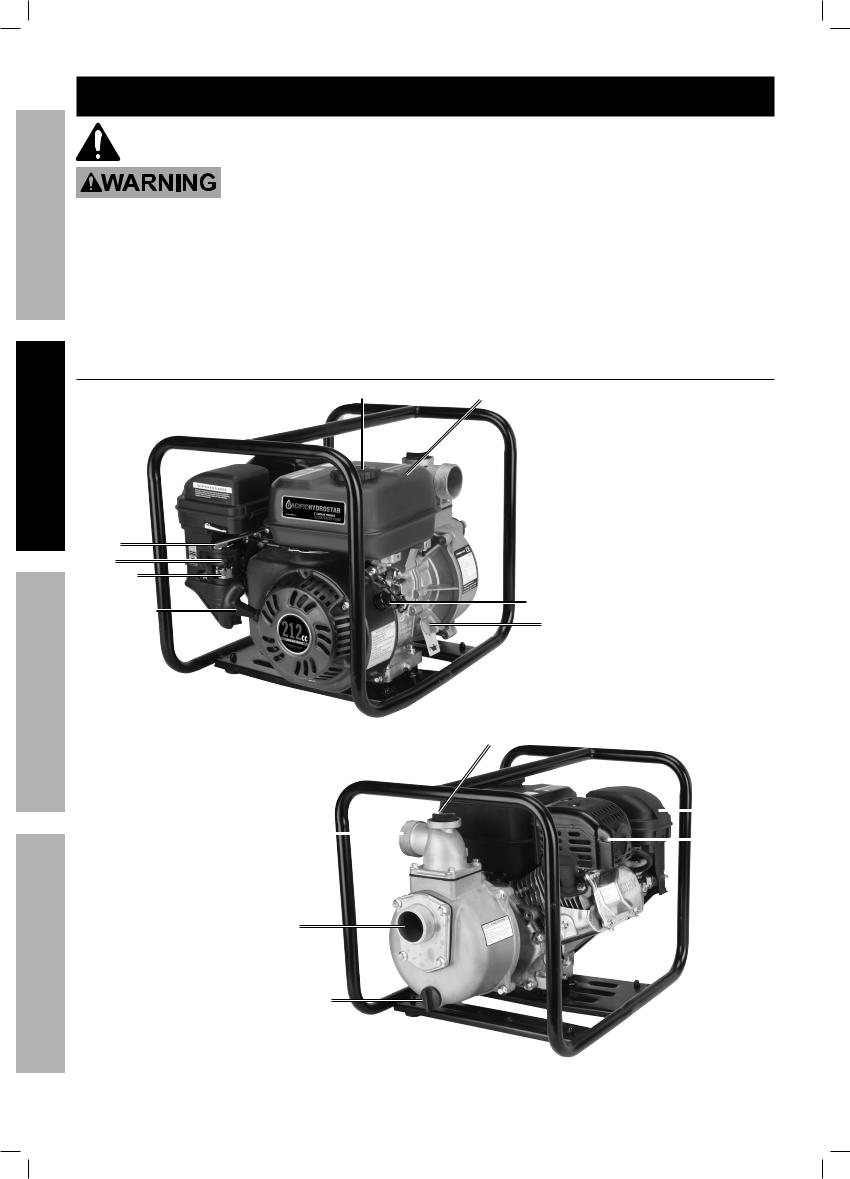
SAFETY
Set Up
Read the ENTIRE IMPORTANT SAFETY INFORMATION section at the beginning of this manual including all text under subheadings therein before set up or use of this product.
TO PREVENT SERIOUS INJURY:
Operate only with proper spark arrestor installed.
Operation of this equipment may create sparks that can start fires around dry vegetation.
A spark arrestor may be required. The operator should contact local fire
agencies for laws or regulations relating to fire prevention requirements.
At high altitudes, the engine’s carburetor, governor (if so equipped), and any other parts that control the fuel-air ratio will need to be adjusted by a qualified mechanic to allow efficient high-altitude use and to prevent damage to the engine and any other devices used with this product.
The emission control system for this Engine is warranted for standards set by the U.S.
Environmental Protection Agency. For warranty information, refer to the last pages of this manual.
Controls
SETUP
Throttle
Choke
Fuel Valve
Starter Handle
OPERATION
MAINTENANCE
Page 6
Fuel Tank Cap |
Fuel Tank |
Engine Switch
Oil Dipstick
Priming Cap
Discharge Port |
|
|
|
|
|
Air Filter |
|
|
|
|
|
||||
|
|
|
|
|
|||
|
|
|
|
|
|
Muffler |
|
|
|
|
|
|
|
||
|
|
|
|
|
|
||
|
|
|
|
|
|
|
|
|
|
|
|
|
|
|
|
Intake Port
Water Drain Plug
For technical questions, please call 1-800-520-0882. |
ITEM 69774 |
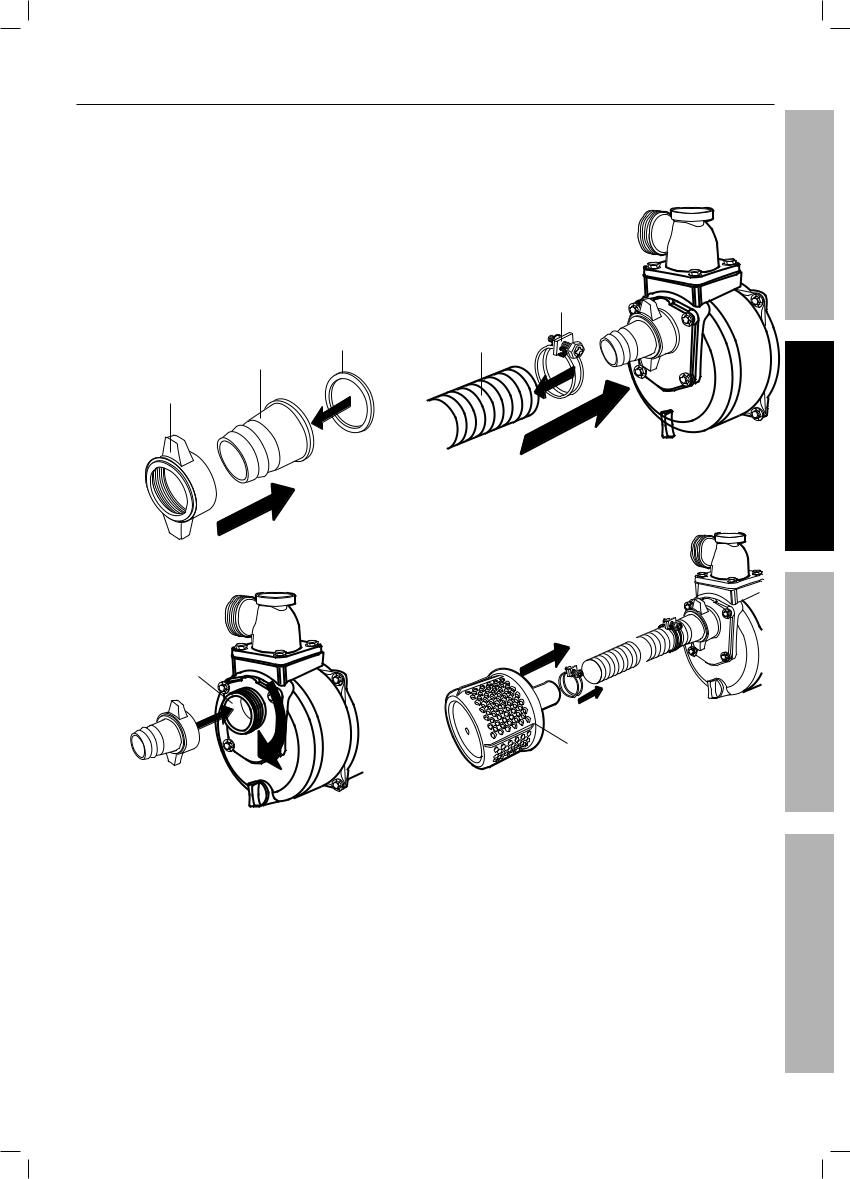
Connecting Hoses
Note: Hose coupling components and hoses not included.
Note: The Suction Hose (not included) MUST be reinforced with braided material or have non-collapsible construction. Do not use a hose with an inside diameter smaller than 2″
(pump’s intake and discharge port diameters).
CAUTION: Do not over-tighten Hose Clamps as the clamp may damage the hose or other components.
1.Slide one of the Hose Coupling Rings over one of the Hose Couplers (a), then place a Gasket on the end of the Hose Coupler (b).
Gasket
Hose Coupler |
|
Hose Coupling Ring |
b |
|
a
2.Thread the Hose Coupling Ring onto the Intake Port (a), and turn clockwise until fastened securely (b).
3.Slide one of the Hose Clamps over the end of the suction hose (a). Slide the Hose onto the Hose Coupler (b). Use a screwdriver (not included)
to tighten the Hose Clamp until secure.
CAUTION: Use only a non-collapsible intake hose.
Hose Clamp
Suction Hose
a
b
4.Slide a Hose Clamp over the other end of the suction hose (a). Slide the Intake Strainer into the end of the suction hose (b). Use a screwdriver to tighten the Hose Clamp until secure.
SAFETY
SETUP
Intake Port
b
a
Intake Strainer
OPERATION
MAINTENANCE
ITEM 69774 |
For technical questions, please call 1-800-520-0882. |
Page 7 |
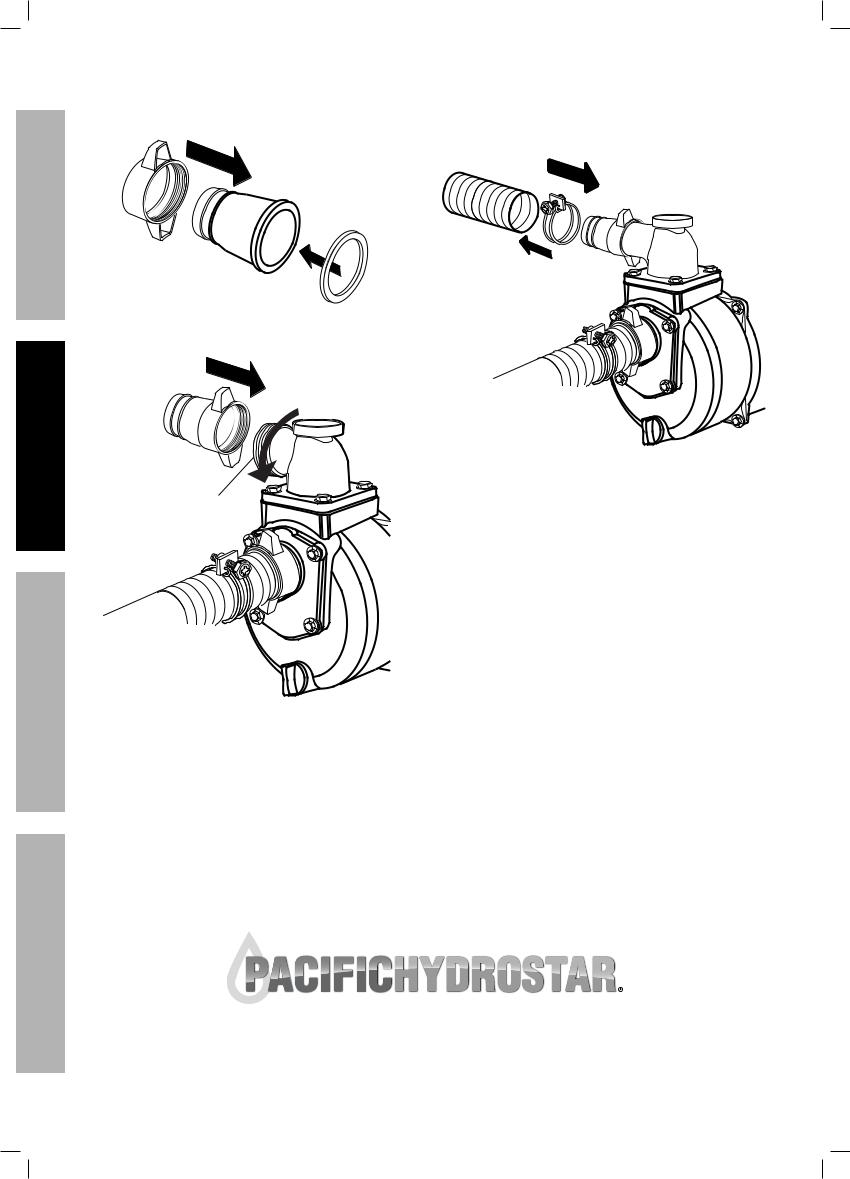
5.For the discharge hose, slide a Hose Coupling Ring over the remaining Hose Coupler (a) and place a Gasket onto the end of the Hose Coupler (b).
a
SAFETY |
b |
|
6.Thread the Hose Coupling Ring clockwise onto the Discharge Port until tightened securely.
SETUP
Discharge Port
OPERATION
MAINTENANCE
7.Slide a Hose Clamp over the end of the Discharge Hose (a). Slide the Discharge Hose onto the Hose Coupler (b). Use a screwdriver to tighten the Hose Clamp until secure.
b
a
Page 8 |
For technical questions, please call 1-800-520-0882. |
ITEM 69774 |
